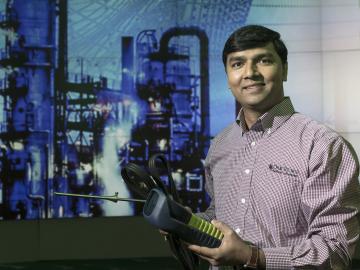
Filter News
Area of Research
- (-) Clean Energy (60)
- (-) Neutron Science (23)
- Advanced Manufacturing (6)
- Biological Systems (1)
- Biology and Environment (4)
- Building Technologies (1)
- Climate and Environmental Systems (2)
- Computational Engineering (1)
- Computer Science (8)
- Fusion Energy (6)
- Materials (55)
- National Security (5)
- Nuclear Science and Technology (11)
- Quantum information Science (3)
- Supercomputing (31)
- Transportation Systems (1)
News Topics
- 3-D Printing/Advanced Manufacturing (12)
- Artificial Intelligence (2)
- Bioenergy (8)
- Biomedical (3)
- Biotechnology (1)
- Clean Water (5)
- Composites (2)
- Computer Science (8)
- Cybersecurity (1)
- Energy Storage (6)
- Environment (15)
- Grid (2)
- Machine Learning (2)
- Materials Science (7)
- Mercury (1)
- Microscopy (2)
- Nanotechnology (2)
- Neutron Science (18)
- Nuclear Energy (2)
- Physics (2)
- Polymers (1)
- Quantum Science (1)
- Security (1)
- Space Exploration (1)
- Sustainable Energy (8)
- Transportation (10)
Media Contacts

An ORNL-led team's observation of certain crystalline ice phases challenges accepted theories about super-cooled water and non-crystalline ice. Their findings, reported in the journal Nature, will also lead to better understanding of ice and its various phases found on other planets, moons and elsewhere in space.

Tempering, the heating process that gives chocolate its appealing sheen and creamy texture, is a crucial part of crafting quality chocolate. But, at the molecular level, it gets a little tricky, and when done incorrectly, can render entire batches of chocolate gritty and unappetizing.

OAK RIDGE, Tenn., May 14, 2019—Advanced Research Systems, Inc., has licensed a technology designed to automatically refill liquid helium used in laboratory equipment for low-temperature scientific experiments, which will reduce downtime, recover more helium and increase overall efficiency.

OAK RIDGE, Tenn., May 8, 2019—Oak Ridge National Laboratory and Lincoln Electric (NASDAQ: LECO) announced their continued collaboration on large-scale, robotic additive manufacturing technology at the Department of Energy’s Advanced Manufacturing InnovationXLab Summit.

Researchers at the Department of Energy’s Oak Ridge National Laboratory, Pacific Northwest National Laboratory and Washington State University teamed up to investigate the complex dynamics of low-water liquids that challenge nuclear waste processing at federal cleanup sites.
Scientists at Oak Ridge National Laboratory have developed a new, stretchy plant-derived material that outperforms the adhesiveness of the natural chemical that gives mussels the ability to stick to rocks and ships.

Sachin Nimbalkar may have grown up in a small town in the shadows of India’s Sahyadri Mountains dreaming of outer space, but it’s the science of conserving energy in inner space where the engineer has made his mark.

When Scott Smith looks at a machine tool, he thinks not about what the powerful equipment used to shape metal can do – he’s imagining what it could do with the right added parts and strategies. As ORNL’s leader for a newly formed group, Machining and Machine Tool Research, Smith will have the opportunity to do just that.

Ionic conduction involves the movement of ions from one location to another inside a material. The ions travel through point defects, which are irregularities in the otherwise consistent arrangement of atoms known as the crystal lattice. This sometimes sluggish process can limit the performance and efficiency of fuel cells, batteries, and other energy storage technologies.

Scientists at Oak Ridge National Laboratory have developed a low-cost, printed, flexible sensor that can wrap around power cables to precisely monitor electrical loads from household appliances to support grid operations.


